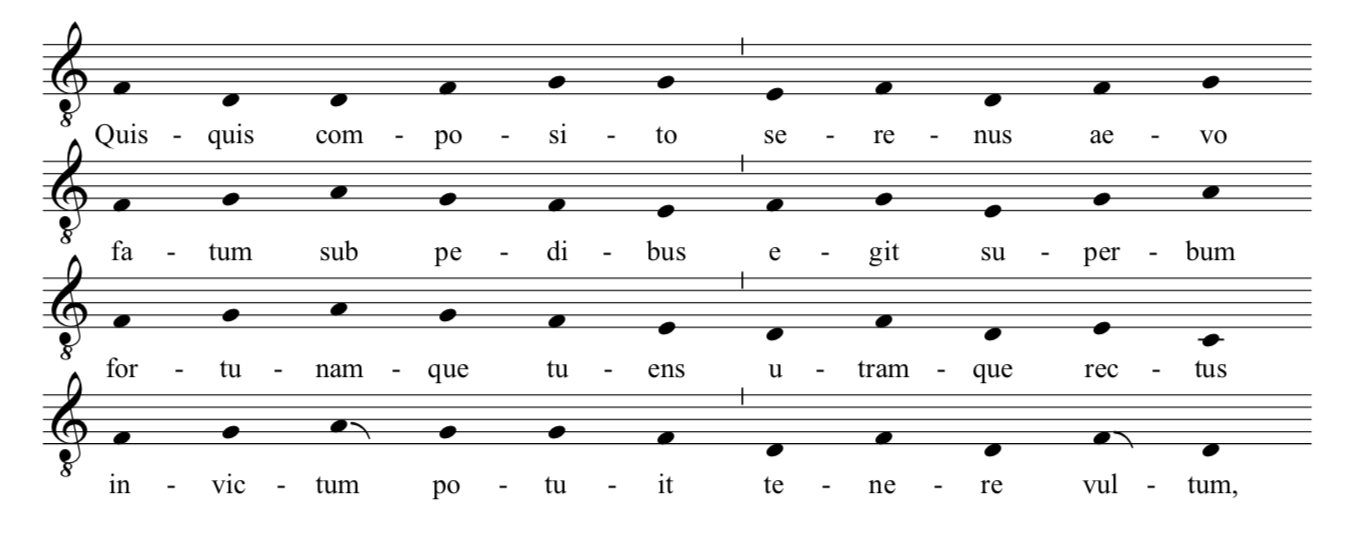A pdf version of this explanation may be downloaded here.
The fourth metrum of the first book is sung by Philosophia, who encourages Boethius to master his emotions in order to return to philosophical reflection. Its eighteen lines are composed of hendecasyllables, which consist of the equivalent of the first half of a dactylic hexameter line followed by two iambs and a last syllable of variable length. Read as prose, the lines take the form of six syllables followed by five with a regular penultimate accent. This provides the same framework of syllables and cadential stresses as found in accentual Asclepiads, such as the Common hymn for one Martyr, Martyr egregie:
The notation added to the Cambridge leaf is remarkable for its syllabic setting and use of two means of indicating pitch height. The first is through diagonal strokes or virgae aligned horizontally at their base but whose highest point varies according to relative pitch. It is evident from this feature alone that the four-line setting includes patterns of melodic return organized around the half line, which may be broadly summarized as follows: ab, cb’, c’d, c’’d’. The second means of indicating pitch is the use of a virga sign that resembles an “r” whose final stroke is extended at a right diagonal, as found at 2.7 egit and 3.6 potuit. This sign is found in other eleventh-century English manuscripts, such as for the monophonic chants in the Winchester Troper, to indicate the upper side of the “mi-fa” semitone step or more simply “fa”.[1] There are two remarkable features of its use here: first, it is employed within repeated melodic segments; secondly, the second sign at 3.6 appears to have been initially drawn as a regular virga to which a right diagonal stroke was then added. Both features point towards a clarifying function for the sign, possibly indicating differences from what might have been expected at these points.
The features noted so far suggest a setting of Quisquis composito in a hymnic style, but there are no clear parallels in terms of contour with surviving melodies for hendecasyllable hymns. In the absence of a specific model for reconstruction, a technique for reciting hexameters has been used as an informing practice. As may be observed below in both the early twelfth-century Beauvais Circumcision Office and in a slightly more elaborate form in the Later Cambridge Songs (copied in the late twelfth or early thirteenth century), dactylic verses could be recited using a minor-third recitation formula.[2] In both cases, a minor third is outlined within the dactylic foot, with the higher note on the dactylic ictus, and either successively lower notes on two following shorter syllables or a single lower note on the following long.
Opening trope element to Matins Verse In principio erat verbum, Circumcision Office, Beauvais (ed. Arlt)
Section of a two-part troped Benedicamus Domino, Later Cambridge Songs (ed. Stevens)
This recitation technique appears relevant in this case since there is a near systematic association between metrical longs and higher pitches in the melodic contour in the neumes recorded on the Cambridge Songs leaf for Quisquis composito. With this recitation principle in mind, the tone f is used in the proposed reconstruction below on all accented syllables in the first line, and a low d is used for the signs indicated by a relatively low horizontal stroke. Beginning line 2 on f and following the indicated contour by step serves to align “fa” with the extended “r” virga after the caesura. Opening after the caesura in line 2 in this way puts the melody one step higher within the modal scale than in the previous line; indeed, drawing attention to this may have been the purpose of the special sign. Repeating the first half of line 2 in the third line leads the second half to return to a minor third axis, falling to an open cadence on the subfinalis (the note below the final) at the end of the line. The fourth line opens with another repeated profile, albeit adapted to accord with the indication of the “fa” step by the extended virga at the tone before the caesura, thereby defeating the expected cadence on mi at this point as in the previous two lines. The final half line returns to the minor third axis with short syllables sung on the low d and long syllables on f. The reconstructed melody given above was prepared in conjunction with Benjamin Bagby and Hanna Marti, who collaborated in a series of creative practical experiments. Extension of the four-line melody across the eighteen-line metrum proceeded by expanding the second strophe through internal melodic repetition to six lines. A version of the explanation above was first published in Sam Barrett, ‘Creative Practice’, pp. 279-81. For a second surviving notation from Anglo-Saxon England for thismetrum, see Barrett, The Melodic Tradition, vol. II, p. 197.
[1] See Susan Rankin, The Winchester Troper: Facsimile Edition and Introduction, London: Stainer and Bell, 2007, pp. 29-30.
[2] Examples reproduced from Wulf Arlt, Ein Festoffizium des Mittelalters aus Beauvais, 2 vols. Cologne: Volk, 1970, vol. 1, p. 46; and John Stevens, The Later Cambridge Songs, New York and Oxford: Oxford University Press, 2005, p. 144.





